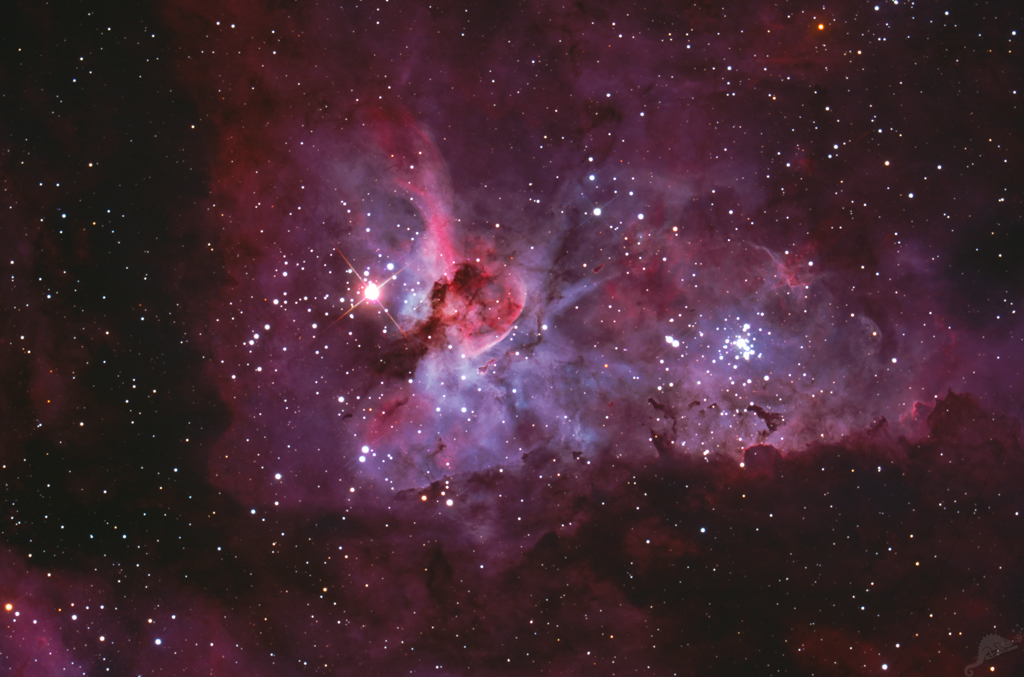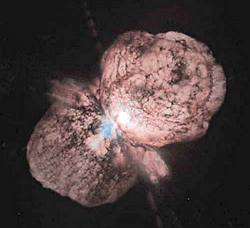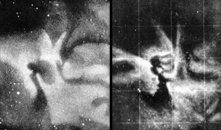 |
ROOISAND OBSERVATORY DeepSky | SITEMAP HOME ROOISAND |
|
 |
|||
| « back to overview Nebulae | Load higher resolution (2700 x 1800 Pixel) | Object description |

The picture shows the central section of the bright and big Carina nebula in the constellation Ship's Keel. In comparison to last year's more wide angle image with the 150 mm Zeiss APQ at Onjala one can see the entire magnificence of the delicate brighter and darker parts of the nebula around Eta Carinae (brightest star in the picture) and the Keyhole nebula.
The nebula complex is already visible during late dusk. The Carinae nebula is a hugh star forming region where new stars are born, giving birth to new stars since about 2 Million years. It contains enough 'material' for the creation of about a million stars of different sizes. In the 19th century, the astronomer John Herschel wrote during his observations of the southern sky: "… Es ist auch nicht einfach, mit Worten einen vollen Eindruck von der Schoenheit und Erhabenheit des Schauspiels zu vermitteln ... so wie es durch solch herrliche und endlose Sternprozession eingeleitet wird, fuer die es eine Art Hoehepunkt bildet ... " Basically, what he wrote is that it is not easy to find words to describe the impression of beauty and grandness one gets when looking at such magnificent and endless star procession for which it is a highlight …
Eta Carinae is one of the most mysterious and most instable stars known to us and has a very interesting history. It is estimated that Eta shines five million times brighter than the sun. The history begins in the year 1677 when Edmond Halley did a first scan of stars in the southern sky. Halley registered this star with a brightness of the 4th stellar magnitude and did not note any further specialties.
However later observers of the southern sky noticed that the stars shone brighter than Halley described it. In 1837 John Herschel discovered that Eta Carinae became brighter and brighter. Six years later - in 1843 - the star was almost as bright as Sirius and the second brightest overall. Because the distance of Eta Carinae was well known, one could calculate that the stars was five million times brighter than the sun in 1843. After that the brightness went down to about an 8th stellar magnitude today (1998).
In the 60ies, when infrared astronomy got established, one noticed that Eta Carinae was the brightest single object in the sky at a wavelength of 20 microns. Together with its optical radiation the star's luminosity today is still million times stronger than our sun. What we can observe directly today is in fact not the star itself anymore.
| Visually, the 17" PlaneWave Astrograph at Roisand shows an oval, bright, deep orange shining object of about 8-12 arc seconds (about 0.5 light years) already at average magnification. At higher magnification a small egg-shaped nebula with brighter sections which gives it an almost humanoid shape. The Australian astronomer Thackeray named it 'Homonkulus Nebula' for that reason. The Homonkulus Nebula consists of gas and dust which were emitted by Eta Carinae in 1843 and which are now hiding the star itself. The nebula's spectrum shows that the star within it is extremely unstable. The star feeds the nebula with star material (about 0.1 sun masses per year) which contains a very high nitrogen content which must originate from Eta Carinae's core. The nebula expands with a speed of ca. 500 km/s. It is clear that the star Eta Carinae reached the end of its live. In a few thousand years or maybe even in just some hundred years the star will explode as a supernova and will be the brightest object in the sky after the sun and the moon. |  |
| Eta Carina, Hubble Space Telescope » |
"Herschel's Keyhole Nebula" is right next to Eta Carinae. Its optical appearance is closely connected to the brightness variations of Eta Carinae. The keyhole partly consists of dark clouds which block the view to regions behind. The dark semi-circle shaped upper structure seems to be more of deepening of the dark clouds. This deepening seems to expand and has its own name - the Eta Carinae-II-Ring. In 1843 Herschel also saw bright nebula parts in the southern part of the nebula which are completely vanished today. They are interpreted as reflection nebula which were directly illuminated by Eta Carina back at the time.
 |
The
picture to the left shows a drawing by John Herschel from 1840. The marked star
positions are very precise so that one can superimpose it with today's
photographs and to visualize changes (the non-matching stars can be explained
by drawing errors or proper motion of the stars). The bright nebulas which
Herschel drew between Eta Carianae and the keyhole are not visible anymore
today. « Load high resolution picture of Herschel's drawing |
||
|
 |
 |
 |
 |
 |
| Moon | Solar System | DeepSky | Widefield | Miscellaneous |
